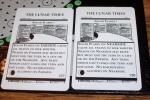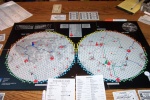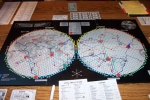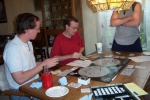
|
Lunar Rails A game by M Robert Stribula Published by Mayfair Games, Inc. Players: 2 to 6 Time: 3 to 4 hours (about 1 hour per player) Reviewed by Ed & Susan Rozmiarek |

|
Lunar Rails is Mayfair's latest game utilizing the Empire Builder system. This game falls into the "crayon rails" category. Other games from Mayfair in the series include Empire Builder, Euro Rails, India Rails and British Rails. In these games, the players compete in running a train company by building rail networks and delivering loads to make money.
This is more of a first look preview than a full review. Both Susan and I have only had the chance to play this game once. We would normally play a game several times before doing a review, but due to the length of the game I'm not sure we're going to get many chances to play the game soon.
Lunar Rails is the first true "crayon rails" game we have played. We had heard a lot of good things about this style of game and have been interested in trying one out. We own and have played a couple other similar German style games where you build and draw a network, Dampfross and Funkenschlag. Dampfross is the closest to the Lunar Rails in that you are building a train network but the goal (building a network used in a series of races) is different. In Funkenschlag, you are building a network to power cities and you must also buy and fuel the power plants. Both of the games I have enjoyed and would rate highly.
Components: I must say that we have gotten pretty spoiled over the last few years with the high quality of the components of the German & European produced games. Mayfair's own recently produced imports Domaine and Settlers of the Stone Age have been manufactured in Germany and have high production values. So, we were a little disappointed in Lunar Rails.
Opening the box you find a thick puzzle cut board, a set of six crayons, six matching tokens that are used as train markers, a bag of white plastic poker chips, a sheet of "commodity" stickers, two decks of cards and a rulebook. The production values are decent but are a step below what I have become accustomed to. Before playing, you must place the commodity stickers on the poker chips. There are 95 of these so this is a time consuming process. The tray in the box does have a nice section devoted to sorting and holding the commodity chips during play. Unfortunately, you must keep the box flat for the tray to work well. If you stand the box up on its end, the commodity chips can easily fall out of their bins.
According to the rulebook, the crayons that come with the game are special crayons that will not smear when wiped off. (In fact, you are warned not to use standard crayons.) However, these crayons do not work very well. In our games, we tried to use them but quickly gave up as the lines they drew were very hard to see so we switched to a set of dry erase pens which worked very well. Note that the rulebook states not to use dry erase markers but they have worked well for us as long as the board is erased at the end of the game.
The board is composed of six pieces that are puzzle cut to fit together. On the board are two large circles, one depicting the near and one the far side of the moon. The maps contain many large, medium and small lunar cities along with a hex grid of dots (or "mileposts" in game terms) that indicate the terrain. The players will build track between these mileposts during the game. The board also contains a legend for map items and the associated building costs. A neat feature of the map is the ability to "wrap around" the two sides of the moon since the actual moon is a sphere. Color coded letters on the edge of each side of the moon match an identical letter/color on the other side, showing where routes can connect. This makes distances between some cities much shorter than they initially appear.
Game play: The goal in Lunar Rails is to be the first player to connect his rail network to seven of the eight major cities and to have 250 million dollars at the end of his turn. Each player starts with 60 million dollars and a level I locomotive or "Loco". Each turn a player may move his train and then build on to his network and/or upgrade his train. As an exception, on the first two turns the players may only build and upgrade. Each player should carefully examine their initial Demand cards to make sure their early track builds set up the ability to make a delivery or they will be out of money early.
Building/Upgrading: Each turn, the player may spend up to 20 million dollars to add on to his rail network or upgrade his Loco. The cost of each track segment between mileposts is based on the terrain type and whether it is connecting to a city milepost.
In addition to adding on to his track, a player may upgrade his Loco. Each player starts with a level I Loco that can carry two loads and can move 10 spaces per turn. Each upgrade costs a flat 10 million dollars and either increases the load by one or the speed by one. The highest level Loco in the game is a type V which can haul three loads with a speed of 16 mileposts per turn.
Demand cards Each player always has three Demand cards displayed in front of him. Each card lists three cities, the resource to be delivered to each, and the payoff for successful delivery of that resource to that city. The card is discarded when one of the deliveries is made, so it is only possible to fulfill one of the three deliveries listed on a single card. Players draw a new demand card as soon as they make a successful delivery. If a player does not like his demand cards, he may discard all three and draw three new ones, but this takes his entire turn. He does not get to move his train nor build track that turn. In addition to the demand cards, there are random event cards mixed in the deck that must be resolved when drawn.
Moving/Delivering loads At the beginning of his turn before building, a player can move over track from milepost to milepost up to the number depicted on his Loco card. As he moves, he may pick up and drop off loads as he goes, never carrying more at any one time than his Loco's capacity. He may move over other players' track, but he must pay each player whose track he used 4 million dollars per turn for the privilege. If he makes a successful delivery as depicted on one of his Demand cards, he immediately stops and draws a new card from the Demand deck. If he draws an event card, the instructions on the card must be carried out immediately. He then draws again, carrying out any event cards until he draws a Demand card. He then may continue moving if he is able.

What's this? Solar flares on both sides of the moon at the same time? Someone please explain how that can happen (and it did).
Commentary:
-
Ed's Comments:
As I said early on, I have only had the chance to play Lunar Rails once.
This was a four player game that lasted about five hours.
For each of us, this was our first "crayon rail" game, but we have all played a large number of
games including other "drawing" games.
My general reaction to the game was luke warm. I felt that the game was too long for the enjoyment and challenge provided. If the game were about half as long as it was, it think it would have been more enjoyable. I guess I have been spoiled by the German style games I have been playing the last few years which pack more into a shorter time. A few weeks after playing Lunar Rails I played Age of Steam for the first time and when that game was over, I was wanting to play it again. I didn't have that same feeling with Lunar Rails.
Besides that game length, there were a few game play issues that bothered me as well. First off, the game is very solitaire like. There is some very minor competition for the limited number of loads. However, in our game this only came into play once and for a very short time. Maybe in a six player game this would be more of a factor. Also, since every player has his own demand cards, each player is off in his own world trying to maximize his play. Other than the possibility of using another player's track, there is very little interaction between the players. For most of the game, I didn't even know what the other players were trying to deliver and it really didn't matter much that I didn't know.
Due to the limited player interaction there seemed to be very few ways to catch the leader. In our game it was pretty obvious that Jon was the leader about midway though the game and we could not find ways to slow him down. And as it turned out, Jon did win, but it took another 2 hours for that to occur.
Another item about the game that I did not like was the randomness of the demand and event cards. Each person has three demand cards, each with three demands on it. However, even with these nine possible deliveries to make, the large number of possible city combinations on the map made it difficult to plan efficient routes. Some people have suggested that we needed to be more willing to exchange our demand cards to get a new set (which we did not do much in our game). That seems to me like a poor fix and a painful thing to do in the game as you must spend an entire turn to exchange your cards.
One suggestion for this we have read about is that each player get four demand cards instead of three. I would like to try this out to see if it helps. Another thing I would like to try is public demands. Several demand cards could be laid out next to the board (one per player?) which could be filled by any player. This should help with the lack of good demands to fill and might also increase the player interaction as players might race to fill a good public demand. I would like to hear if anyone has tried this as a variant.
One of the other items that slowed the game down for us was our unfamiliarity with the lunar map, the locations of the cities and what they produce. Since each demand card lists three cities with three different demands, everytime someone got a new card, they had to spend time finding the three cities on the map and determining the cities where the material to fill the demand could be found. The game does comes with a text based city location and production chart, a two page pull-out from the center of the rules that may be cut into four copies. However, it would have been really nice to have the location of the city listed on the demand cards, perhaps with a small graphic showing its general location and which side of the moon.
Lastly, the event cards were just a pain in our game. They added a random factor that just seemed to lengthen the game, something which the game does not need. I do think that the events fit the game (solar flares, meteor showers, etc). One funny thing did happen in our game with the event cards. Two solar flare events were drawn close together, so we had solar flares hitting both sides of the moon at the same time. Someone with a Ph.D. in astronomy will have to explain the physics behind that one to me.
With all these complaints, you might think I hated the game, I didn't. The core of the game works well and is pretty well balanced which is something you would expect for a game with several predecessors. The players are challenged on how to build track the most efficiently because money is in short supply, especially early on. If the players do not plan their routes well and manage the demands they are trying to fill, you can easily run into financial trouble. In fact, one of the players in our game did run out of money and we had to break out the loan rule from the variations section of the rulebook.
Since I have only played the game once, I definitely want to try it again, maybe with some of the tweaks I have read on the net to speed up the game. Right now I would have to rate the game a '5' on a 10 point scale and it could go up to a 6 if the tweaks can shorten the game. I would also like to play another one of the rail games to see how much of a factor the unfamiliar lunar map is to the speed of the game.
Susan's Comments: Lunar Rails is the first game in the Empire Builder series that I have played. I have only played one game, so these comments are based solely on initial impressions.
My reaction on first opening the box pretty much mirrors Ed's. The components, while functional and sturdy, are very basic and bland. Sprucing up the cards and resource chips with some color would greatly enhance the appearance of the game. On a more positive note, the rules were exceptionally clear and well written.
I had never really been interested in playing "crayon rail" games because I was under the impression that they were all long and complicated. Well, I was correct about the length but I was pleasantly surprised to discover the mechanics are really quite simple. Very simple, in fact. I was fortunate in my one three-player game in that one of the players was very experienced with the series and both of the other players had played Lunar Rails before. Their familiarity with the rules helped keep the game moving. Our game took about 3.5 hours.
Some of the comments I have read, usually phrased as criticism, concerning games in this series proved to be true. One such charge is the excessive downtime between turns. In our game, our unfamiliarity with the imaginary cities of the moon and their resources made for a lot of painful and time consuming searching as we planned our moves. Although player aids were provided that listed the region of the map for each city, it would have been nice if this information was printed on the cards. Even better would be some sort of color coding for each region. Hopefully repeated plays would mitigate this problem somewhat. I did often find myself needing plenty of time to plan my own move so some of the downtime was welcome and not annoying.
Another charge often leveled at these games is the lack of player interaction. This solitaire feel did not bother me in the least. I found myself so engrossed with my own planning that the fact that it was actually a competition often felt secondary in importance in my mind. I was too busy trying to plan the most efficient deliveries to worry about anyone else unless they got in my way. And indeed they did at times by grabbing the best connections to cities. As for cooperative interaction, we used each other's track several times. So while player interaction is minimal when compared to other games, there is some.
There is some randomness to the game that may or may not appeal. Players are at the mercy of the luck-of-the draw as to what their delivery assignments are. The random event cards can deliver a severe setback to players through no fault of their own. They can also give a player a significant advantage. In my game, the eventual winning player was able to capitalize on a lucky event card draw that gave him an early cash bonus, enabling him to upgrade his engine and build more track much earlier than the others. On-the-other-hand, the cards do add some spice and uncertainty to the game, which is fitting to the theme.
Conclusion: The unique wrapping feature of the moon map in Lunar Rails will probably delight veterans to the series by providing a new twist. However, it is probably not the best choice to introduce a new players such as ourselves to the series. We would have enjoyed learning the game much more had we not been struggling so much to find the locations. Also, the long length of the game means it will probably only see occasional play. However, we were quite taken with the simple building and puzzle-like mechanics of the game. Enough so that we have purchased a copy of Empire Builder so we can experience the game system on a more familiar map. We can see why the series has a large following and are looking forward to exploring it further as a break from the shorter games that we normally prefer.
| Other Web information: |
This page viewed
E-mail Ed Rozmiarek with questions or problems concerning this page.
Copyright © 2003, Ed Rozmiarek



